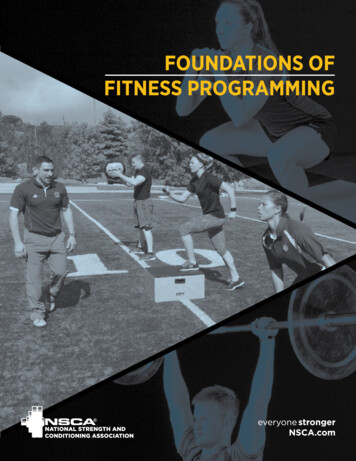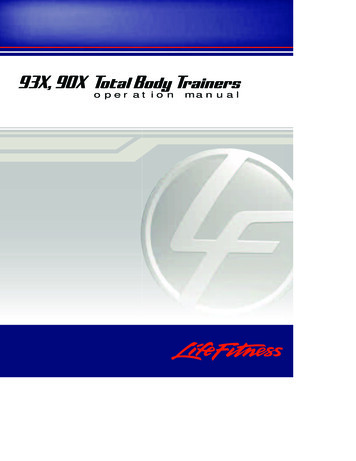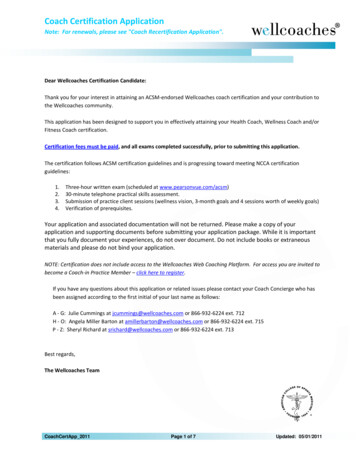
Transcription
FOUNDATIONS OFFITNESS PROGRAMMING
NATIONAL STRENGTH ANDCONDITIONING ASSOCIATION (NSCA)FOUNDATIONS OFFITNESS PROGRAMMINGDEVELOPMENT TASK FORCE MEMBERSNick Clayton, Joe Drake, Scott Larkin, Robert Linkul,Mike Martino, Mark Nutting, and Nick TumminelloCopyright 2015 National Strength and Conditioning Association. All Rights Reserved.
TABLE OF CONTENTSFOUNDATIONS OF FITNESS PROGRAMMING OVERVIEW 5About 5Why was the FFP developed? 5Designing Individualized Fitness Programs 61.Consultation and Discussion of Goals 62.Evaluate Health History Forms and Perform a Fitness Assessment 63.Establish S.M.A.R.T. Goals 6a.Agree Upon the Goals 7b.Define Roles and Responsibilities 7c.Identify and Address Roadblocks 74. Develop the Training Program 7IMPLEMENTING THE FOUNDATIONS OF FITNESS PROGRAMMING 8FOUNDATIONS OF FITNESS PROGRAMMING: INSTRUCTIONS AND APPLICATION 9MOBILITY, MOVEMENT PREPARATION, AND FLEXIBILITY TRAINING 10Warm-Up Benefits 10Dynamic Warm-Up Recommendations 11Dynamic Warm-Up Programming Considerations and Recommendations 11Flexibility Training 11PROGRAM DESIGN: BASICS 12Classifying Training Status and Training Frequency Recommendations 12Sequencing of Training 13Exercise Selection, Regression, and Progression 13Training Variables 14Assigning Load 14Program Design Methods and Descriptions 15PROGRAM DESIGN: PHASES OF TRAINING 16Muscular Endurance 16Sequencing Example for Muscular Endurance Goal 17Hypertrophy 17Sequencing Example for Hypertrophy Goal 18Muscular Strength 18FOUNDATIONS OF FITNESS PROGRAMMING NSCA.COM/PROGRAM-DESIGN-ESSENTIALSCopyright 2015 National Strength and Conditioning Association. All Rights Reserved.
TABLE OF CONTENTSSequencing Example for Muscular Strength Goal 19Muscular Power 19Sequencing Example for Muscular Power Goal 19NUTRITION AND PERSONAL TRAINING 20Scope of Practice 20Practical Recommendations for Weight Loss 21Practical Tips for Weight Gain 21Common Myth: “Bulking” and the “Pump” 21Constant State of Flux 21CARDIOVASCULAR TRAINING 22Specificity of Aerobic Endurance Training 22Training Frequency and Duration 22Progression 23Cardiovascular Training Types and Exercise Intensity 23Resistance Training’s Effect on Endurance Performance 23Resistance Training and Endurance Performance Key Points 23CORE TRAINING 24Defining the Core 24Core Connections 25Multi-Joint Exercises and Core Activation 25Core Training and Progression 25APPENDIX 27Appendix A. Initial Consultation Sample Questions/Considerations 28Appendix B. Dynamic Warm-Up Exercise List 29Appendix C. Primary Movement Patterns and Exercises 30Appendix D. Core Training Exercises 31REFERENCES 32FOUNDATIONS OF FITNESS PROGRAMMING NSCA.COM/PROGRAM-DESIGN-ESSENTIALSCopyright 2015 National Strength and Conditioning Association. All Rights Reserved.
FOUNDATIONS OFFITNESS PROGRAMMINGOVERVIEWABOUTThe Foundations of Fitness Programming (FFP) was writtento highlight the essential, research-based components ofdesigning fitness programs, and to “bridge the gap” by providingrecommendations to apply research to practice. It is not meant toreplace individualized training, nor is it a “cookie-cutter,” one-size-fitsall program. It is meant to serve as a resource and educational tool forpersonal trainers to design training programs quickly and effectively,which are progressive in nature and specific to the needs and goals oftheir clients.The FFP provides supporting rationale and scientific references forthe recommendations made, and these references can be found in theappendix. Practical training tips and links to relevant journal articlesand exercise technique videos have also been added.There are corresponding spreadsheet “templates” formatted toprovide periodized training programs that include drop-downmenus for exercise selection, pre-programmed exercise variablesthat correspond to the phases of training, and recommendations foraspects of a personal training session including dynamic warm-up,resistance, cardiovascular, and flexibility training.WHY WAS THE FFP DEVELOPED?As the worldwide authority on strength and conditioning, theNational Strength and Conditioning Association (NSCA) supports anddisseminates research-based knowledge and its practical applicationto improve performance and fitness. Since the practical applicationoften provides the greatest challenge to novice personal trainers,the FFP was developed to bridge that gap, helping personal trainersFOUNDATIONS OF FITNESS PROGRAMMING NSCA.COM/PROGRAM-DESIGN-ESSENTIALSCopyright 2015 National Strength and Conditioning Association. All Rights Reserved.
6efficiently and effectively design training programs based onscientific principles, specific to the individual needs of their clients.Personal training is often referred to as an art form (i.e., the artof applying research-based knowledge to individual situationsincluding, but not limited to, a client’s goals, current/previousinjuries, health and fitness status, level of physical competency,self-efficacy, self-confidence, etc.). While there are general trainingprinciples that apply to everyone, there are a number of factorsthat affect program design and client motivation. Regardless,programs should adhere to the principles put forth by the NSCA.These principles (Haff G. H., 2012) are:1.Specificity (individuality)Designing training programs/workouts with a specific goalin mind based on each client’s individual needs. Specificityin training can be accomplished by targeting musclegroups, energy systems, speed of movement, movementpatterns, and/or muscle action types (Haff G. H., 2012).2.OverloadThe training stress (based on frequency, intensity, and typeof exercise as well as recovery processes) placed on a clientshould exceed the training stress experienced during theprevious workout. This is accomplished by increasing theload, sets, reps, or by decreasing the rest periods.3.ProgressionSimilar to overload, progression (or progressive overload)refers to the systematic modification of a training programover time. In addition to exercise intensity, progressionalso refers to frequency and increasing the difficulty ofexercise selection (advancement from low-skill to high-skillexercises). Exercises are progressed on an individual basisrather than a pre-determined schedule, based on a client’sability and speed of adaptation.4.VariationVariation is considered planned variety in exercise selectionand training variables.Keeping in line with these principles, the FFP provides arecommended (linear periodization) training sequence thatconsists of muscular endurance, hypertrophy, strength, andpower phases for relatively untrained through advanced clients.While other periodization models exist, a linear model issuggested for beginners.DESIGNING INDIVIDUALIZED FITNESS PROGRAMSA training program should be based on the individual needsand abilities of a client in order to maximize the effectivenessand efficacy of the training program as well as decrease therisk of injury or overtraining. These needs and abilities shouldbe determined during the initial consultation and fitnessassessment, and then updated every 4 – 6 weeks of training.The following steps identify a systematic process used todevelop the training program:1.Consultation and Discussion of GoalsThe initial consultation is an opportunity for the personaltrainer to establish professional credibility, determineclient-trainer compatibility, and develop rapport and trustwith the client. A personal trainer establishes credibilityby “debunking” fitness myths and explaining the scientificrationale and programming necessary to reach their goals.Rapport and trust are developed when the personal trainerasks the “right” questions and demonstrates active listeningto the client’s responses; thereby, increasing the likelihoodthat a client will discuss the underlying motivational factorsdriving them to achieve their goals. These factors lay thefoundation for open communication between the personaltrainer and client, and increase the likelihood that theirgoals will be attained.During the initial consultation, personal trainers shouldask questions pertaining to training history, resources, andother obstacles (e.g., time constraints, equipment access,family commitments etc.), as well as begin the initialdiscussion of training goals. This information provides the“road map” to designing effective programs; it tells thetrainer where the client wants to go and identifies wherethey are starting from. It is important to note that goalsshould be discussed in general terms during this initialconsultation. S.M.A.R.T. goals (see below) can only beaccurately set following the evaluation of health history andfitness assessment.Refer to Appendix A for sample questions to ask during theinitial consultation.2.Evaluate Health History Forms and Perform a FitnessAssessmentThe results of the health history forms and fitnessassessments are used to design a client’s individualtraining program. This data includes a baseline forfuture comparison, identification of current fitness level,clarification of goal setting, and assistance in prescribinginitial exercise frequency, volume, and intensity.3.Establish S.M.A.R.T. GoalsSuccessful programs train clients at a level that matchestheir needs and abilities to meet their specific goals.Following the initial consultation, health history evaluation,and fitness assessment, the personal trainer and the clientshould work together to develop specific, measurable,action-oriented, realistic, and timely (S.M.A.R.T.) goals. Tipsfor effectively establishing goals include:FOUNDATIONS OF FITNESS PROGRAMMING NSCA.COM/PROGRAM-DESIGN-ESSENTIALSCopyright 2015 National Strength and Conditioning Association. All Rights Reserved.
74.a.Agree Upon the GoalsThe personal trainer and client should develop andagree upon the goals together. The client providesthe “why” (i.e., their motivation for achievingthese goals), while the personal trainer determineswhether the goals are realistic, including timeframe to achieve goals, and develops and explainsthe overall plan for achieving those goals.b.Define Roles and ResponsibilitiesThe personal trainer should explain his/her rolein helping the client achieve the goals as well asthe client’s role and responsibility in achieving thegoals, and address the clients expectations of thepersonal trainer.c.Identify and Address RoadblocksThe personal trainer and client should identifyany potential issues that may impede progressand develop alternative options if, or when, theseissues arise.Develop the Training ProgramAt this point, the personal trainer has all the necessaryinformation to develop a specific training plan that matchesthe needs and abilities of a client to reach the agreedupon goals. This plan should include frequency of training,exercise selection, and training variables.FOUNDATIONS OF FITNESS PROGRAMMING NSCA.COM/PROGRAM-DESIGN-ESSENTIALSCopyright 2015 National Strength and Conditioning Association. All Rights Reserved.
IMPLEMENTING THEFOUNDATIONS OF FITNESSPROGRAMMING
FOUNDATIONS OFFITNESS PROGRAMMING:INSTRUCTIONS ANDAPPLICATIONWhile there are many ways to organize an individual trainingsession, the FFP provides recommendations that cover thefollowing training components:1.Mobility, movement preparation, and flexibility training2.Resistance training3.Basic nutrition4.Cardiovascular training5.Core/stability trainingIt is assumed that at this point, the personal trainer has takenthe client through and completed the initial consultation, healthhistory evaluation, fitness assessment, and goal setting process.The following sections identify key points related to the applicationof key training components.There are program design templates available for download. Thesetemplates are formatted for the personal trainer to design periodizedtraining programs with his/her clients.In addition, a list of other example exercises can be found in theappendix. These exercises are linked to short exercise technique videoswith key points and coaching cues.The templates and videos can be found on the Program DesignEssentials page.FOUNDATIONS OF FITNESS PROGRAMMING NSCA.COM/PROGRAM-DESIGN-ESSENTIALSCopyright 2015 National Strength and Conditioning Association. All Rights Reserved.
MOBILITY, MOVEMENTPREPARATION, ANDFLEXIBILITY TRAININGWARM-UP BENEFITSThe term “warm-up” refers to preparatory exercises performedprior to engaging in activities that are more vigorous and includesthree types: passive, general, and specific. Regardless of the typeselected, the overall purpose remains the same: to prepare the bodyfor the demands of the upcoming workout, in particular to increasetemperature-dependent physiological responses. These responses:1.increase muscle temperature causing more forceful contractionsand quicker relaxations,2.increase blood temperature to working muscles, unloadingmore oxygen to working muscles, and3.increase range of motion around joints (Hedrick, 2012).It is important to note that dynamic warm-up/stretching is not thesame as flexibility (e.g., static stretching) training. Flexibility refersto the range of motion at a specific joint or series of joints, and istypically assessed in non-weight bearing situations. Conversely,dynamic stretching refers to performing movements specific to a sportor movement pattern (Hedrick, 2012). Within the context of dynamicstretching are the terms mobility and movement preparation (prep).Mobility refers to a client’s ability to achieve a posture or position, ismore global in nature, and emphasizes multi-joint movements andstabilization (Brooks & Cressey, 2013). Movement prep is an evenbroader term used to describe all of the various methods used toimprove mobility during a warm-up. Performing a dynamic-basedwarm-up prior to physical activity appears to improve performanceand may provide increased resistance to muscle injury (Hedrick, 2012).FOUNDATIONS OF FITNESS PROGRAMMING NSCA.COM/PROGRAM-DESIGN-ESSENTIALSCopyright 2015 National Strength and Conditioning Association. All Rights Reserved.
11DYNAMIC WARM-UP RECOMMENDATIONSA dynamic warm-up routine starts with about 5 min ofcardiovascular activity, starting at a low intensity andprogressing to a moderate intensity (i.e., to the point ofdeveloping a light sweat). This cardiovascular warm-up isfollowed by 5 – 15 min of movement prep that progresses fromgeneral exercises to ones that are more specific. Each movementprep exercise is performed for approximately 20 – 25 yards,or 5 – 10 reps. A list of dynamic warm-up exercises can befound in Appendix B; the exercises listed are linked to videosthat provide exercise technique tips and coaching cues.In addition to the dynamic warm-up exercises included in theappendix, some clients may benefit from additional movementpreparation techniques, such as self-myofascial release. Thistechnique may improve range of motion without subsequentperformance detriments (MacDonald, et al., 2013).DYNAMIC WARM-UP PROGRAMMING CONSIDERATIONSAND RECOMMENDATIONSPersonal trainers should have a conscious reason for prescribingexercises for their clients and can support their recommendationswith scientifically sound research. This statement applies to allphases of a workout, including the dynamic warm-up routine.When designing a warm-up routine, personal trainers shouldask themselves:1.What cardiovascular activity is most appropriate for theclient and involves the most amount of muscle mass?2.What exercises are planned in the upcoming workout?3.a.What joints and muscles will be involved?b.What is the overall level of mobility required toperform the exercise?c.What planes of motion will be involved?d.What speed of movement will be involved?Consider the following warm-up example for a client with limitedmobility who will be performing the barbell back squat in theupcoming workout. After a 5-min warm-up (walk to jog to run), asample mobility routine may include the following:BODY AREA/JOINTMOBILITY DRILLWARM-UPMOVEMENTAnkleAnkle Wall MobilitySingle-LegQuarter SquatsHip3-Way LungeHip Bridge/ThrustersThoracic SpineT-Spine RotationsSuspensionTrainer RowsTotal BodyBodyweight Squat/Goblet SquatsNeurologicalBack Squat Warm-Up SetsFLEXIBILITY TRAININGResearch suggests that although static stretching andproprioceptive neuromuscular facilitation (PNF) are viableoptions for increasing range of motion, they may decrease forceproduction and subsequent performance (Mojock, Kim, Eccles,& Panton, 2011). This decrease in performance is attributed tomusculotendinous unit (MTU) stiffness and decreased neuralactivation of the skeletal muscles (Mojock, Kim, Eccles, & Panton,2011). For this reason, flexibility training via static stretching andPNF are recommended when the muscles are already warmedup, either at the end of a workout session or during a separateflexibility focused session.Does the client have any specific mobilityrestrictions or exercise contraindications?Recommendations:1. Start with general movements that mobilize joints thatwill be used in the upcoming workout or need consistentwork, such as the ankle, hip, and thoracic spine (Myer, et al.,2014).2.Select additional mobility drills based on the individualneeds of the client.3.Progress to specific warm-up movements/exercises thatmeet the physical and physiological demands of theupcoming workout.FOUNDATIONS OF FITNESS PROGRAMMING NSCA.COM/PROGRAM-DESIGN-ESSENTIALSCopyright 2015 National Strength and Conditioning Association. All Rights Reserved.
PROGRAM DESIGN:BASICSCLASSIFYING TRAINING STATUS AND TRAINING FREQUENCYRECOMMENDATIONSIn order to progress a client through a training program safely andeffectively, the personal trainer must first know where to start whenassigning training variables, such as frequency of training. Thefollowing table provides a means of classifying clients based on theduration and frequency of their current training program and theiroverall training experience.EXAMPLE OF CLASSIFYING TRAINING STATUS*CLASSIFICATIONDURATION OF CURRENTTRAINING PROGRAMCURRENT FREQUENCYTRAINING INTENSITYRECOMMENDEDFREQUENCYBeginner0 – 6 months0–3Low-medium2–3Intermediate8 – 12 months3–4Medium-high3 (total body)4 (split routine)Advanced 1 year 4High-very high4–6Adapted, with permission, from tables 15.1 and 15.2 on pages 350 and 352 of J.W. Coburn and M.H. Malek (eds.), 2012, NSCA’s essentials of personal training,2nd ed. (Champaign, IL: Human Kinetics).*The classifications in this table provide an example; exact client classification cannot be definitively described.FOUNDATIONS OF FITNESS PROGRAMMING NSCA.COM/PROGRAM-DESIGN-ESSENTIALSCopyright 2015 National Strength and Conditioning Association. All Rights Reserved.
13SEQUENCING OF TRAININGEXERCISE SELECTION, REGRESSION, AND PROGRESSIONPeriodization is the systematic process of planned variationin a training program and is commonly used in athleticpopulations, where peaking for an event is critical. Considera football team who just ended their fall season. After a shorttime off, their periodized training program will begin witha general preparation phase in the off-season and progresstoward a peaking/competitive phase. This general preparationphase will begin shifting from high volume/low intensity tolow volume/high intensity as the football season nears. Howdoes a personal trainer apply this concept to a client whowants to lose weight, build muscle, or “get in shape?”Becoming proficient at an exercise requires coaching (from thepersonal trainer) and practice (from the client). Clients must beable to perform movements that challenge their ability withoutputting them at risk of injury and still provide them with anappropriate training stimulus in order to adapt.Before answering that question, it is important to understandthat the purpose of periodization is to improve physicalperformance progressively towards a training goal throughthe manipulation of training variables. This purpose adheresto the general training principles of overload, progression, andvariation previously discussed. The personal trainer shouldunderstand that different training goals have complementaryeffects, and that by sequencing different phases of trainingthose same principles are adhered to. For example, a clientwhose primary training goal is strength would benefit fromcompleting a hypertrophy phase prior to completing a strengthphase. The hypertrophy phase will result in an increasedcross-sectional area (e.g., more muscle mass) which canincrease total force production potential (Haff G. H., 2012).It is generally accepted that all clients should begin aresistance training plan based on either muscular endurance orhypertrophy to establish a training base for the developmentof other specific goals. Intermediate and advanced clientswho have already developed this training base may performa shorter muscular endurance or hypertrophy phase ormove directly into training for their specific goals.The following provides an example linear periodization sequence,each lasting 2 – 4 weeks (Haff G. H., 2012):1.Muscular endurance phase2.Hypertrophy phase3.Strength phase4.Power phase (intermediate and advanced clients only)As an example, consider Mari, a 45-year-old female who justsigned up for an eight-week personal training program. She willbe getting married in eight weeks and her goal is to look greatin her wedding dress. In training terms, she wants to decreaseher percentage of body fat. Mari’s training age is 0, meaning shehas never stepped foot in a weight room and describes herself as“clumsy.” Her personal trainer thinks that one of the best overallexercises is the barbell back squat, which requires a moderatelevel of technical skill to be performed safely with an adequateload to elicit a training effect. The personal trainer also knows thatmost lumbar disk injuries occur when the spine is flexed (Durall& Manske, 2005), especially when loaded. If the personal trainerwere to spend 15 minutes a session, twice a week working onbarbell back squat technique, it would be using about 25% of hertraining time on learning exercise technique.Instead of getting stuck on the process, the personal trainershould focus on the product (or outcome of performing theexercise). If the personal trainer thinks about the product of theexercise (incorporating a multi-joint movement involving themajority of muscles in the body) he/she may choose to “regress”the exercise. Regression refers to selecting a less complicatedexercise using the same movement pattern. In this case, the trainermay choose to select a goblet squat, assisted squat, or even a wallsit. Progression is the opposite; it involves selecting an exerciseof a similar movement pattern with a higher technical degree. Forexample, a progression from the back squat may include the frontsquat or overhead squat. Going back to Mari, performing a lesstechnical exercise, like the goblet squat, would be a more effectiveexercise (given her eight-week time frame) in building muscle and/or burning calories.EXERCISE REGRESSION AND PROGRESSIONLESS TECHNICALIt is important to note that many different methods ofperiodization/sequencing can produce significant results; however,there is no “one best way” (Cissik, Hedrick, & Barnes, 2008). Aftercompleting the initial training sequence of 3 – 4 months, thepersonal trainer should sequence the training phases to meet thespecific needs/goals of the client, and then manipulate trainingvariables every 2 – 4 weeks to prevent stagnation and encouragecontinuous adaptation.FOUNDATIONS OF FITNESS PROGRAMMING NSCA.COM/PROGRAM-DESIGN-ESSENTIALSCopyright 2015 National Strength and Conditioning Association. All Rights Reserved.MORE TECHNICAL
14The following table provides recommended training regressions and progressions that can be used for primary movement patterns. Notethat these are recommendations; the best regressions and progressions are the ones that best reflect the individual client’s strengthsand weaknesses.EXAMPLE EXERCISE REGRESSIONS AND PROGRESSIONSMOVEMENTREGRESSION #1REGRESSION #2STANDARDPROGRESSION #1PROGRESSION #2SquatWall SitGoblet SquatBack SquatFront SquatOverhead SquatHingeHip Bridge or 45 Hip ExtensionCable RomanianDeadlift (RDL)RDLSingle-Leg RDLKettlebell SwingsLungeSplit SquatAssistedReverse LungeWalking LungeMultiplanar LungeSplit-Squat JumpsPush(bodyweight)Modified orWall Push-UpStabilityBall Push-UpPush-UpArcher Push-UpPlyometric Push-UpPush(external load)Machine Chest PressBarbell Bench PressDumbbellBench PressSingle-ArmDumbbell PressSplit-StanceSingle-ArmCable PressHorizontal PullSeated RowDumbbell RowBent-Over RowSplit-StanceCable RowSplit-Stance CableRow with RotationVertical PullLat PulldownAssisted Chin-UpChin-UpPull-UpWeighted Pull-UpPressMachineShoulder PressKneelingMilitary PressMilitary PressSingle-ArmMilitary PressPush PressTRAINING VARIABLESASSIGNING LOADThe next sections provide descriptions of each training phase.These training phases include muscular endurance, hypertrophy,muscular strength, and muscular power. Training variables areincluded within each phase. These training variables include:Load is commonly expressed as a percentage of 1RM (onerepetition maximum), which is the heaviest load that can belifted once while maintaining correct form/technique during agiven exercise. Load and the number of reps performed havebeen shown to be highly associated to specific training goals.For example, heavier loads ( 80% of 1RM) with lower reps areassociated with gains in strength, while lighter loads ( 70%of 1RM) with higher reps are associated with gains in muscularendurance (Haff G. H., 2012).1.Sets per exercise2.Reps per exercise3.Rest between sets4.Load, which is expressed as a percentage of one-repetitionmaximum (1RM)Note that these exercise variables apply to the primary exercises(multi-joint/compound). Assistance exercises (single-joint/isolated) are typically performed with lower intensity and higherrepetition ranges (primarily in the strength and power phases). Forexample, during the strength phase, the primary lifts (e.g., squats,bench press, etc.) utilize high intensity/low reps, but the assistanceexercises (e.g., leg extension, biceps curl, etc.) utilize low intensity/high reps.Before assigning load, the personal trainer must determine the1RM of the desired lift. This can be attained by performing a true1RM test or by using a multiple repetition maximum (RM) test toestimate the 1RM.The advantage of performing a 1RM test is that a true 1RM testwill provide the most accurate result; however, this methoddoes have some disadvantages. Novice clients may lack thetechnique necessary to allow a safe 1RM test. Some clientsmay have the necessary technical competence to complete alift safely, but lack confidence to complete the test safely. It isessential that the personal trainer take the client’s training age,technical competency, and confidence into consideration whendeciding which method they will use to determine a 1RM. It isalso important to note that 1RM tests should be reserved forcompound/multi-joint lifts because these lifts are typically bettersuited for use with large loads. Testing assistance exercises (e.g.,single-joint exercises such as the biceps curl) for a 1RM should beavoided. (Haff G. H., 2012)FOUNDATIONS OF FITNESS PROGRAMMING NSCA.COM/PROGRAM-DESIGN-ESSENTIALSCopyright 2015 National Strength and Conditioning Association. All Rights Reserved.
15An alternative to 1RM testing is multiple RM testing, which can beused to estimate a client’s 1RM. While a 1RM test directly measuresthe maximal amount of weight a client can lift, multiple RM testingdetermines a 6RM – 10RM load that can be used to indirectlyestimate a client’s 1RM using the Training Load Chart found on theProgram Design Essentials page.PROGRAM DESIGN METHODS AND DESCRIPTIONSThe following are program design terms used in subsequentsections with brief explanations: Single-set system: performing one set of a given exercise(as opposed to performing multiple sets of an exercise) Multiple-set systems (standard exercise order):performing multiple sets of an exercise before moving onto subsequent exercises Complex set: combining a strength exercise followed by apower exercise (e.g., squats followed by depth jumps) Compound set: performing 2 – 3 exercises for similarmuscle groups Circuit training: performing one set of multiple exercisesbefore repeating Supersets: performing alternating exercises for opposingmuscle groups Pyramid loading: increasing training load progressivelyand then decreasing Drop sets: performing a set to muscular failure with agiven load and continuing immediately with additionalsets at a lighter load Heavy negatives: performing eccentric-only work with aload greater than concentric 1RM Forced reps: performing additional reps past volitionalfatigue with the help of a spotter Cluster sets: also known as rest-pause sets, utilize interrepetition rest intervals of 10 – 30 s Accommodating resistance: incorporating bandsand chains to free weight exercises to exert isokineticresistance throughout the full range of motion Partial range of motion: performing an exercise inpartial ranges of motion to increase strength at aparticular joint angleFOUNDATIONS OF FITNESS PROGRAMMING NSCA.COM/PROGRAM-DESIGN-ESSENTIALSCopyright 2015 National Strength and Conditioning Association. All Rights Reserved.
PROGRAM DESIGN:PHASES OF TRAININGThe FFP and the corresponding training templates follow th
fitness assessment. Refer to Appendix A for sample questions to ask during the initial consultation. 2. Evaluate Health History Forms and Perform a Fitness Assessment The results of the health history forms and fitness assessments are used to design a client’s indiv










